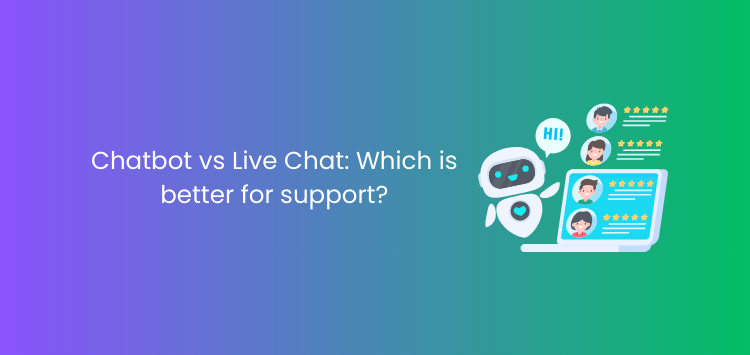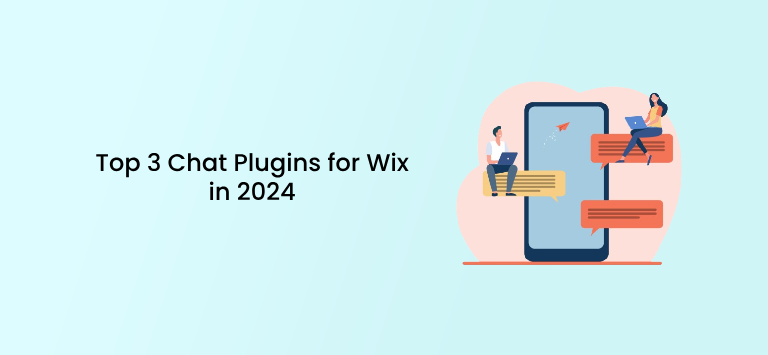These two communication channels have become increasingly popular thanks to their ability to enhance customer engagement and improve satisfaction rates. While both of these channels have their unique benefits, it can be a bit confusing for businesses to select the one that is better for their support. The purpose of this article is to provide a detailed comparison between chatbots and live chat and help you understand which one is better for your business. Let’s dive in!

What are Chatbots?
Chatbots are computer programs designed to interact with users through text-based or spoken language, simulating human conversation. They leverage artificial intelligence (AI) and natural language processing (NLP) to understand and respond to customer queries. These software-based assistants can be embedded on websites, messaging apps, or other digital platforms to provide automated support, engage customers, and offer information.
Pros of chatbots
1. 24/7 Availability: One of the primary advantages of chatbots is their ability to provide round-the-clock support. Unlike human agents, chatbots don’t require rest or breaks, making them available to assist customers at any time of the day or night. This constant availability ensures that customers can receive assistance when they need it most, regardless of time zones or business hours.
2. Scalability: Chatbots excel at handling a high volume of customer interactions simultaneously. As a business grows, chatbots can easily adapt to increased demand without requiring the hiring and training of additional support agents. This scalability not only reduces operational costs but also ensures that customer inquiries are addressed promptly, even during peak periods.
3. Consistency: Chatbots deliver consistent responses to customer queries. They follow predetermined guidelines and rules, which means that every customer receives the same information and assistance. This consistency eliminates variations in the quality of support, providing a standardized experience for all customers.
4. Efficiency: Chatbots excel in efficiency, as they can quickly process and respond to customer queries. They reduce the average response time, resulting in faster issue resolution and a more streamlined customer support experience.

5. Data Gathering: Chatbots can collect and store valuable data from customer interactions, including common queries, customer preferences, and pain points. This data can be analyzed to gain insights into customer behavior and needs, helping businesses make data-driven decisions to enhance their products or services.
Limitations and challenges of chatbots
1. Limited Contextual Understanding: While chatbots have made significant advancements in natural language processing, they can still struggle with understanding nuanced or complex conversations. They may misinterpret context, leading to inaccurate or irrelevant responses. This limitation can frustrate customers who expect more in-depth and contextual interactions.
2. Lack of Emotional Intelligence: Chatbots lack emotional intelligence, which is a crucial aspect of customer support. They can’t perceive and respond to human emotions such as frustration, anger, or empathy. In emotionally charged situations, customers may find chatbot interactions unsatisfactory, leading to a negative customer experience.
3. Inability to Handle Complex Scenarios: Chatbots are best suited for routine and straightforward tasks. They may struggle when faced with intricate or multifaceted issues that require human judgment, creativity, or decision-making. In such cases, customers may require the intervention of a human agent.
4. Continuous Learning and Maintenance: Chatbots, especially AI-powered ones, need ongoing training and maintenance to stay effective. They must be updated with new information, customer feedback, and evolving conversational patterns. Neglecting this upkeep can result in outdated, inaccurate responses.
5. Initial Implementation Challenges: Setting up a chatbot can be a complex process, involving the integration of software, data sources, and scripting. Businesses may encounter challenges during the initial implementation, requiring technical expertise and resources.
What is Live Chat?
Live chat is a real-time customer support channel that allows users to engage with human agents or support representatives via text-based conversations on a website, application, or messaging platform. It offers a direct and immediate connection between customers and a human representative, making it a valuable tool for resolving issues, answering questions, and providing assistance in a highly interactive manner. Live chat provides a dynamic platform for users to interact with knowledgeable agents who can address their concerns and offer personalized solutions.

Benefits of Live Chat
1. Personalized Assistance: Live chat stands out for its ability to provide personalized support. Customer support agents can address users by their names, reference previous interactions, and offer tailored solutions based on individual needs. This personalization fosters a stronger customer-business relationship and can lead to increased customer satisfaction.
2. Real-Time Problem Resolution: Live chat offers real-time problem resolution, enabling customers to receive immediate help for their inquiries or issues. This real-time interaction is especially beneficial for urgent matters, preventing potential frustration or delays associated with other support channels.
3. Multi-Tasking: Both customers and support agents can engage in multiple conversations simultaneously. For customers, this means minimal wait times, while for businesses, it leads to improved efficiency and resource utilization.
4. Detailed Information Exchange: Live chat allows for the exchange of detailed information, including screenshots, files, and links, making it an ideal channel for troubleshooting technical or complex issues. This rich information exchange often leads to quicker issue resolution.
5. Access to Archives: Live chat conversations are typically saved and can be accessed later, allowing customers and support teams to review past interactions. This feature ensures consistency and facilitates a better understanding of customer histories and needs.

Disadvantages of Live Chat
1. Response Time Variability: Response times in live chat can vary depending on factors such as the number of support agents available and the complexity of customer inquiries. During peak hours or with limited staffing, response times can increase, leading to potential customer frustration.
2. Limited Availability: Unlike chatbots that can operate 24/7, live chat relies on human agents who require rest and have working hours. This limited availability can be challenging for businesses that serve a global customer base across different time zones.
3. Staffing and Training Costs: Maintaining a live chat support team, including recruiting, training, and salaries, can be costly for businesses, especially if they aim to provide 24/7 support. This cost factor can be a drawback for small or resource-constrained companies.
4. Human Error: Live chat interactions are susceptible to human errors, such as typos, miscommunication, or misunderstandings. These errors can sometimes lead to customer dissatisfaction or misinterpretation of information.
5. Customer Waiting Time: In cases where response times are longer, customers may experience waiting times, especially if the chat agent is simultaneously assisting other clients. Prolonged waiting times can negatively impact the customer experience.
Factors to Consider When Choosing
When deciding between chatbots and live chat for customer support consider the following factors:
1. Customer Demographics: Understand your target audience. Younger, tech-savvy customers may prefer an automated chatbot, while older demographics might prefer human interaction.
2. Budget: Assess your financial resources. Chatbots can be cost-effective, but live chat often requires more significant investments in staffing and training. A budget friendly live chat tool to consider is Chatway

3. Support Volume: Analyze the volume of customer inquiries. High volumes might benefit from chatbots, while lower volumes may justify the use of live chat.
4. Complexity of Queries: Consider the nature of customer inquiries. Routine and simple questions can be efficiently handled by a chatbot, while intricate issues may require the expertise of live chat agents.
5. 24/7 Availability: Determine whether your business requires 24/7 support. Chatbots can operate continuously, while live chat often follows set business hours.
6. Integration with Existing Systems: Assess how easily chatbots or live chat can integrate with your existing software, databases, and customer relationship management systems.
7. Customer Expectations: Recognize what your customers expect. Some may prefer instant responses, while others may prioritize personalized interactions.
8. Regulatory Compliance: Ensure that your chosen support method aligns with any industry-specific regulations and data privacy requirements.
9. Scalability: Consider your potential for growth. A solution that can scale with your business is preferable for long-term success.
Best Practices for Implementing Chatbots and Live Chat
Implementing chatbots and live chat effectively requires careful planning:
1. Clearly Defined Roles: Assign distinct roles for chatbots and live chat agents. Clearly define which types of inquiries each channel will handle.
2. Staff Training: Train support agents to work in tandem with chatbots. They should know how to intervene when necessary and provide seamless transitions from chatbot to human support.
3. Ongoing Maintenance: Continuously update and improve your chatbots with fresh data and user feedback. Live chat agents should undergo regular training and skill development.
4. Analytics and Data Utilization: Use analytics to monitor the performance of both channels. Analyze data to understand customer behavior and preferences, enabling you to make informed decisions.
5. Feedback Loops: Establish mechanisms for customers to provide feedback on their support experiences. Use this feedback to fine-tune your support strategies.
Final Thoughts
In conclusion, the choice between chatbots and live chat is not a one-size-fits-all decision. Both options have their strengths and weaknesses, and you should consider their unique circumstances and customer expectations to make the most informed choice. Regardless of whether you opt for chatbots, live chat, or a hybrid approach, the paramount goal is to provide quality customer support. Strive to create a seamless, efficient, and personalized support experience that caters to the diverse needs and preferences of your customers.









